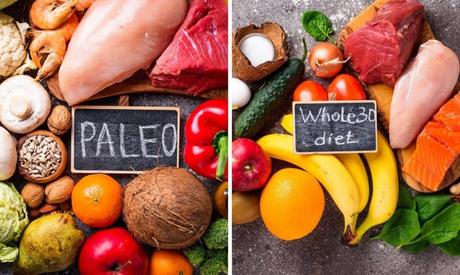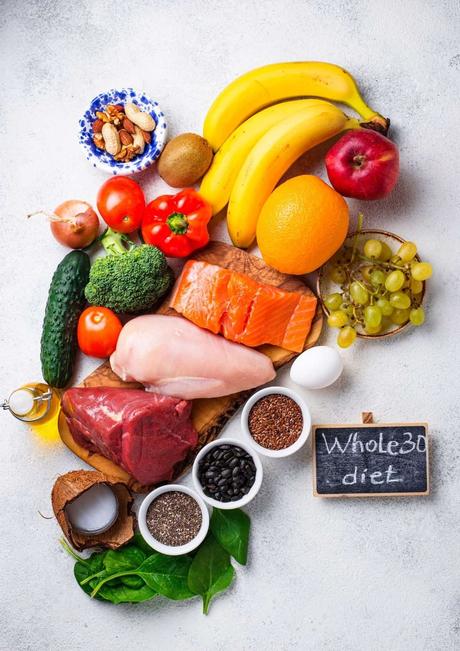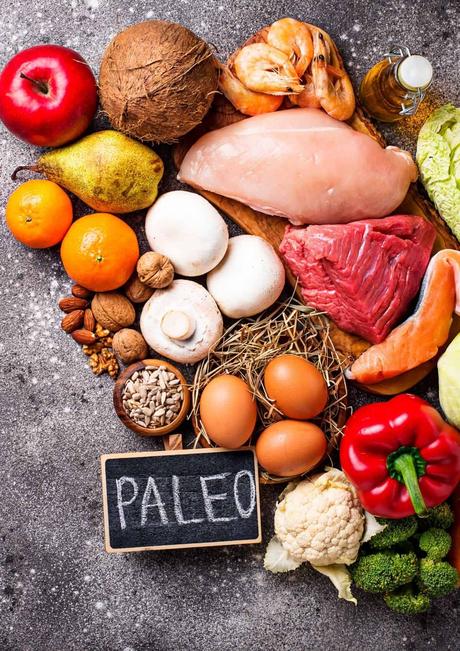This post may contain affiliate links. Please read my disclosure.
Paleo and Whole 30 are both very popular diets with similar philosophies - focusing on unprocessed foods. So what's the difference between the two? We'll look at each diet in detail, explore the pros and cons of each, and I'll give you my verdict on which I think is the best diet for you. Whether you're looking for a new diet, or currently follow either Paleo or Whole 30 and are considering switching, my guide on Paleo vs. Whole 30 is just what you need.

What Is The Paleo Diet?
The paleo diet, also known as the Caveman diet, refers to a dietary plan that resembles what humans would have eaten during the Paleolithic era. This period in time dates between 10,000 and 2.5 million years ago.
The reason for following this diet is to get back to what early human beings used to eat, as it's considered by some to be the most compatible diet with humans' bodies. The Paleo Diet focuses on foods that could have been eaten by hunter gatherers of the Paleolithic era (our paleolithic ancestors) and are considered real food, not processed in any way.
What Food Do You Eat On The Paleo Diet?
The main paleo foods include:
What Do You Avoid On The Paleo Diet?
Seeing as this diet is based on foods that were available as late as 10,000 years ago, it doesn't include entire food groups obtained from farming. Because of this, it means that the following foods are avoided on the paleo diet:
And again, because of the prehistorical aspect of this diet, you wouldn't be able to eat any processed foods as a part of your meal plan.
Pros: Benefits Of The Paleo Diet
The paleo lifestyle offers many benefits to those who follow it, mostly because it avoids processed foods and focuses on consuming whole foods. Processed foods tend to be high in saturated fats, added sugars or high-fructose corn syrup, and sodium, which many argue has given rise to the health problems that we face in today's world.
Health issues such as diabetes / high blood sugar, obesity, digestive issues, low energy levels, high blood pressure, and heart disease are aggravated by the consumption of high amounts of processed foods, which is why many people believe this diet is the better option.
The focus on fresh foods doesn't just mean we avoid unhealthier, processed foods, but also means that we consume a lot of the nutrients and vitamins that our bodies need by eating a diverse range of natural foods.
People who follow a paleo meal plan tend to report better sleep, an improvement in body composition, and sometimes even weight loss.
Cons: Things To Consider
Paleo dieters experience quite a few benefits when starting this diet. The main drawbacks or just things to consider is that this is a long-term diet. True paleo eaters eat this way for life.
So if you start this diet, you have to be able to commit to the restrictive nature of paleo meals for a long time. If you eat paleo for a little while and then stop, you won't sustain the benefits either.
Other things to consider: this diet may be challenging for vegetarians and vegans since legumes and dairy are both not allowed - and those are some of the main sources of plant based protein.
Some carbs are also good for health and energy, so going on a low-carb, high protein diet may not be feasible for everyone - especially athletes, or those who can't eat too much protein (e.g. those with kidney disease or young kids).

What Is The Whole 30 Diet?
Next, we'll look at the Whole 30 diet. This restrictive diet is an elimination diet that lasts for 30 days. It is meant to help you understand any food sensitivities or food allergies you might have. In these 30 days, people follow a clean eating plan and are encouraged to cut out unhealthy foods and habits such as drinking alcohol and smoking for the duration of the 30 days.
After the initial 30 days is up, you start reintroducing foods that you miss back into your diet, carefully monitoring how your body reacts to them. If you are okay and don't notice any negative effects, you can start eating this food again.
This plan is quite strict, however, and if you cheat at any point on this diet, you're encouraged to start again from day 1. The idea behind this diet is that people can 'reset' their bodies and also their relationship to food by cutting out all foods that harm their bodies for a month-long period.
What Do You Eat On The Whole 30 Meal Plan?
The foods you eat on the Whole 30 meal plan are quite similar to those of the Paleo Diet. Let's look at some examples:
As you can see, many of these groups are also found in the paleo diet, with the exception of healthy fats like clarified butter.
What Do You Avoid On The Whole 30 Diet?
Whole30 rules are quite strict when it comes to foods to avoid:
Those following this diet also have to abstain from consuming alcohol and smoking.
Pros: Why Choose The Whole 30 Diet?
First, many people join the Whole 30 plan in the hopes of losing weight. Cutting out sugary, fatty, and processed foods give your body the calorie deficit needed for weight loss.
Another reason people choose this diet is to identify any intolerances they might have for certain types of food. This can be done when you reintroduce food groups back into your diet, monitoring your body's response to each one.
The Whole 30 diet is also marketed as a way to achieve food freedom, and, according to their website, promises to change your eating habits and relationship with food. For those who find it difficult to eat healthily, or have bad eating habits such as bingeing, then the Whole 30 diet is a viable option for resetting your relationship with food.
Cons: Things To Consider
Given how restrictive this diet is, it may be too difficult to stick to. It also may be time intensive due to all the meal prep involved! Lastly, because it eliminates dairy and other calcium rich foods, you need to ensure you're getting enough calcium for bone health.
What Is The Difference Between Paleo And Whole 30?
While both Paleo and Whole 30 are whole food diets, the main difference between the two is the length of time and purpose for going on each one.
The specific foods consumed on each of these diets is somewhat similar. Both are low-carb diets, and both are meant to improve your overall health. In terms of food groups, they're actually pretty similar, both having an emphasis on clean, fresh, and minimally processed foods. Both diets help you make better food choices and eliminate sugar cravings.
While the Whole 30 diet does have space for other foods like clarified butter, the differences in these diets lie mostly in why people choose them and their potential benefits.
Why People Choose Each Diet Plan
When it comes to Paleo vs. Whole30, a major difference is why people choose them. For Whole30, a lot of people who opt for it are wanting to change not just their weight, but their relationship with food too, as well as understand if they have any food sensitivities. They are also looking for a shorter commitment, and an ability to reintroduce some foods over time.
For those who opt for the paleo diet, many want to do so to eat a more natural diet, to make a more permanent change, and are in it for the long haul.
Length of Diet
The Whole30 diet lasts 30 days - typically through a 30-day challenge, whereas the paleo diet doesn't have a set timeline to it, and is meant to be a long-term lifestyle change.
Restrictions
We also see a difference in what is restricted in each of the diets. The paleo diet doesn't ban non-food-related habits such as smoking, whereas the Whole30 diet is much stricter on these things.
How Does The Paleo And Whole 30 Diets Compare To The Ketogenic Diet?
The ketogenic diet is a high-fat diet that takes low carb even further. It is very restrictive when it comes to the net carbs you are permitted to eat each day, because it is meant to put the body into a state of ketosis. But the keto diet does allow you to eat dairy products and even wine, and some other alcoholic beverages (which Whole 30 and Paleo guidelines do not allow).
What Can You Eat On The Ketogenic Diet?
- Meat and Meat Substitutes (tofu and tempeh)
- Fish and Seafood
- Eggs
- Keto Approved Vegetables (cauliflower, broccoli, brussel sprouts, avocado, cabbage, zucchini, spinach, asparagus, kale, green beans)
- Keto Approved Fruit (berries, coconut, lemons, and limes)
- Nuts and Seeds
- Cheese and Full Fat Dairy
- Fats and Sauces (not restrictive in the type of fats allowed)
What Foods Are Avoided On The Ketogenic Diet?
- Sugar and Sugary Foods
- Most types of fruit
- Starchy Foods (all grains even whole grains)

Paleo vs. Whole 30: FAQs
When it comes to Whole30 vs Paleo, a lot of questions remain. While they both have similarities, each plan offers different benefits based on each person's individual health goals. So depending on what you want to get out of your diet, either the Paleo or Whole30 diet will suit your nutrition needs. So let's look at some commonly asked questions on the topic of Paleo vs Whole30.
Which Diet is Easier?
Paleo vs Whole 30: Which Diet Is Better?
Seeing as the Paleo and Whole30 diets are super similar in terms of what foods you eat on them, the defining factor for which plan is better for you really depends on what you want to get out of your diet.
For A Short Term Lifestyle Change
If you're looking to change more than just your diet and physical health, then the Whole30 diet is great for you. It targets the emotional and mental aspects of our diets too and encourages those who are on it to combat their attitudes towards food, as well as the food itself. And because it is a 30 day commitment, it's a great way to try on a new diet.
For A Long Term Option
However, the Whole 30 diet is regarded by many as a fad diet that isn't sustainable in the long term. The month-long Whole 30 timeline restricts this diet from being a long-term lifestyle choice. This is why if you're looking for a long-term option, then the paleo diet may be better for you. It's extremely similar to the foods you would eat on the Whole 30 plan with less of a rigid structure.
Have you tried either of these diets? Let me know about your experiences with them below, and which you prefer!

